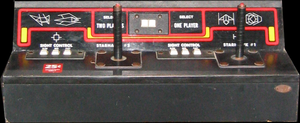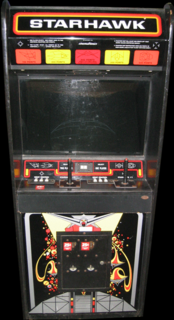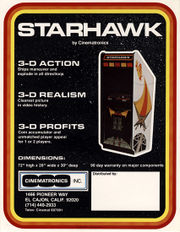Lost In Translation/Star Hawk
| Star Hawk | |
|---|---|
| Manufacturer | Cinematronics |
| Released | 1979 |
| Control Method |
8-way Joystick 4 Button(s) |
| Main CPU | CCPU (@ 5.000 MHz) |
| Sound CPU | Mono Discrete |
| Video Details |
Vector (Horizontal) 0 x 0 pixels 38.00 Hz 32,768 Palette colours |
| Screens | 1 |
| ROM Info | 8 ROMs 4,512 bytes (4.41 KiB) |
| MAME ID | starhawk |
About The Game
Star Hawk is a 3-D arcade video game shoot-em-up which places a strong emphasis on player timing. Players move a cross hair around the screen and must blast the approaching enemy spaceships.
The skill level settings affect how quickly the cross hairs move in response to the joystick input. As the game progresses, the speed of the enemy craft increases. If one particular enemy ship is not destroyed quickly enough, it will zap 800 points off the player's score, with the enemy itself also worth 800 points.
Star Hawk can effectively be played indefinitely, providing the player keeps shooting enough enemy ships.
Trivia
Released in March 1979.
Licensed to Sega for Japan market.
Star Hawk was the first arcade game ever released to be based on the film 'Star Wars'. This game literally came out right after the film. This was an unlicensed translation, but the Tie Fighters and the Death Star inspired background are obvious. This was only the second or third game in history to use an X-Y monitor.
Larry Rosenthal left Cinematronics to form his own company (Vectorbeam). When he left the company, he took all of the development tools that were used for Space Wars with him. Tim Skelly was hired in this time, and was left with nothing to write his games on except for the main board! Luckily, Larry had ran into a time crunch and had to hire a technician to help him out. Tim found the tech, who had the opcodes for the board, and Dennis Halverson was hired to write the macro assembler for the DEC computers used at the company. Cinematronics needed a game, and fast. So rather than wait for the tools to be developed, Skelly wrote Star Hawk on paper using opcodes. The Star Hawk code was the first machine language code that Skelly wrote that actually worked.
Skelly says, "Obviously, things eventually worked out. I managed to crank out Starhawk in time for a winter game show in London. But what still angers me to this day besides being put on the spot like that, is the fact that more than a hundred employees were depending on a new game to maintain their livelihood, and I was clearly chosen as the guy who couldn't come up with one. I think you can see that, under the circumstances, there was no love lost between the Cinematronics and Vectorbeam camps".
Star Hawk came in a large cabinet that had a front that was completely vertical, while the back section sloped away slightly from the marquee. This title actually had two marquees, one with the game logo, and a second one right below it that had some game instructions. The monitor bezel was just tinted plastic with more game instructions below it. The control panel had a pair of odd 8-Way fire button joysticks that looked a bit like hand-grips on a children's bicycle. These were positioned to be used with the right hand, eventually the industry would decide that joysticks go in the left hand, but this one was the other way around. The cabinet features painted side-art of a barely disguised X-Wing swooping down on a barely disguised Death Star, with a few unrelated red and orange bubbles above them.
Scoring
| Target | Points |
|---|---|
| Command ships | 800 |
| Starship | 500 |
| Rocket | 300 |
| Missile | 100 |
| Bomber | 100 |
Staff
- Designed & Programmed By
- Tim Skelly
Cabinet and Artwork
Ports
- Consoles
- GCE Vectrex (1982)






